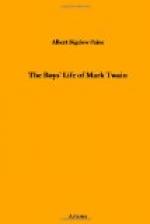Many of the home incidents in the Tom Sawyer book really happened. Sam did clod Henry for getting him into trouble about the colored thread with which he sewed his shirt when he came home from swimming; he did inveigle a lot of boys into whitewashing a fence for him; he did give painkiller to Peter, the cat. As for escaping punishment for his misdeeds, as described in the book, this was a daily matter, and his methods suited the occasions. For, of course, Tom Sawyer was Sam Clemens himself, almost entirely, as most readers of that book have imagined. However, we must have another chapter for Tom Sawyer and his doings—the real Tom and his real doings with those graceless, lovable associates, Joe Harper and Huckleberry Finn.
V.
TOM SAWYER AND HIS BAND
In beginning “The Adventures of Tom Sawyer” the author says, “Most of the adventures recorded in this book really occurred,” and he tells us that Huck Finn is drawn from life; Tom Sawyer also, though not from a single individual, being a composite of three boys whom Mark Twain had known.
The three boys were himself, almost entirely, with traces of two schoolmates, John Briggs and Will Bowen. John Briggs was also the original of Joe Harper, the “Terror of the Seas.” As for Huck Finn, the “Red-Handed,” his original was a village waif named Tom Blankenship, who needed no change for his part in the story.
The Blankenship family picked up an uncertain livelihood, fishing and hunting, and lived at first under a tree in a bark shanty, but later moved into a large, barn-like building, back of the Clemens home on Hill Street. There were three male members of the household: Old Ben, the father, shiftless and dissolute; young Ben, the eldest son—a doubtful character, with certain good traits; and Tom—that is to say, Huck, who was just as he is described in the book—a ruin of rags, a river-rat, kind of heart, and accountable for his conduct to nobody in the world. He could come and go as he chose; he never had to work or go to school; he could do all the things, good and bad, that other boys longed to do and were forbidden. To them he was the symbol of liberty; his knowledge of fishing, trapping, signs, and of the woods and river gave value to his society, while the fact that it was forbidden made it necessary to Sam Clemens’s happiness.




